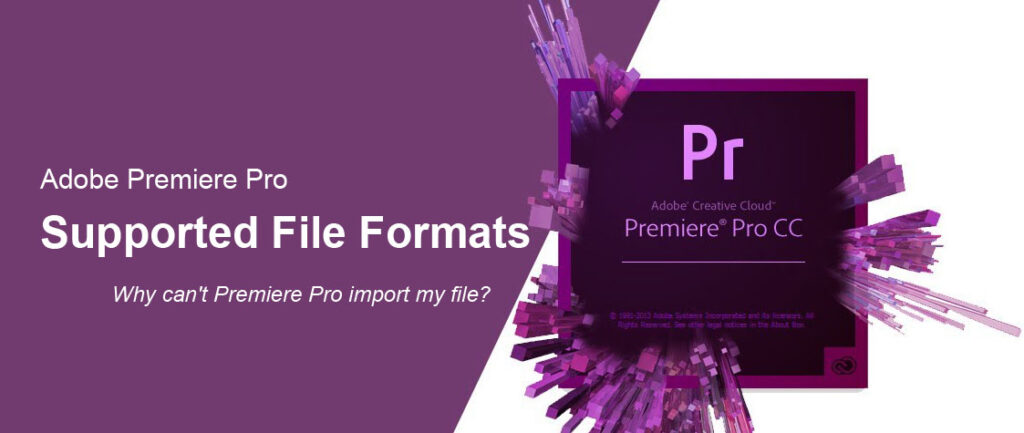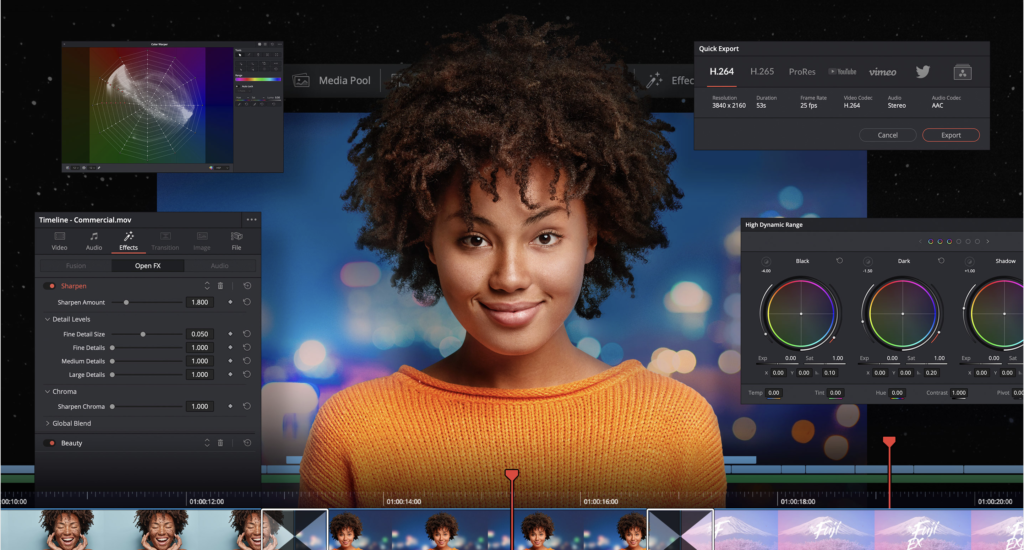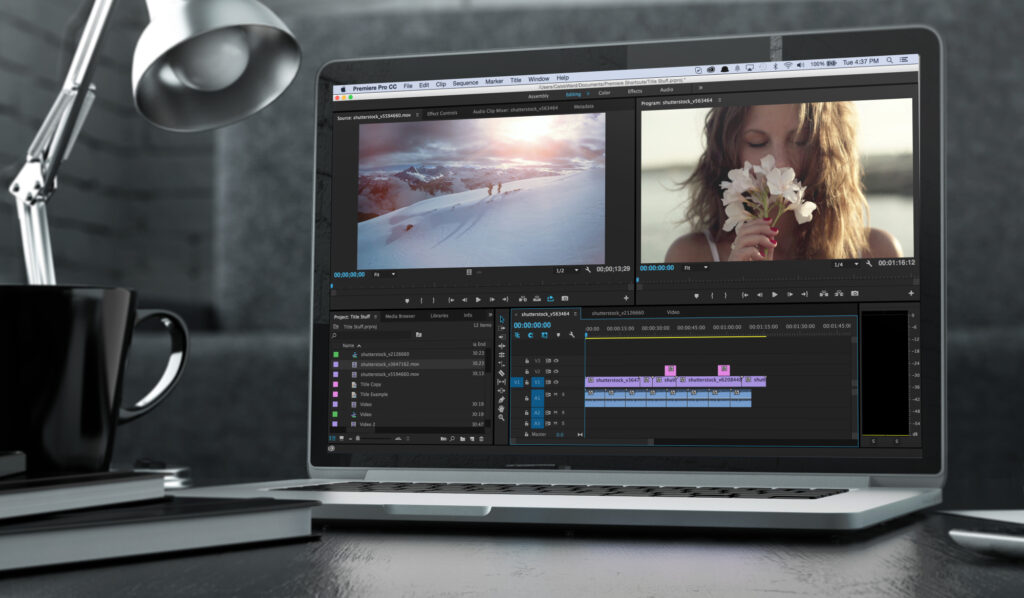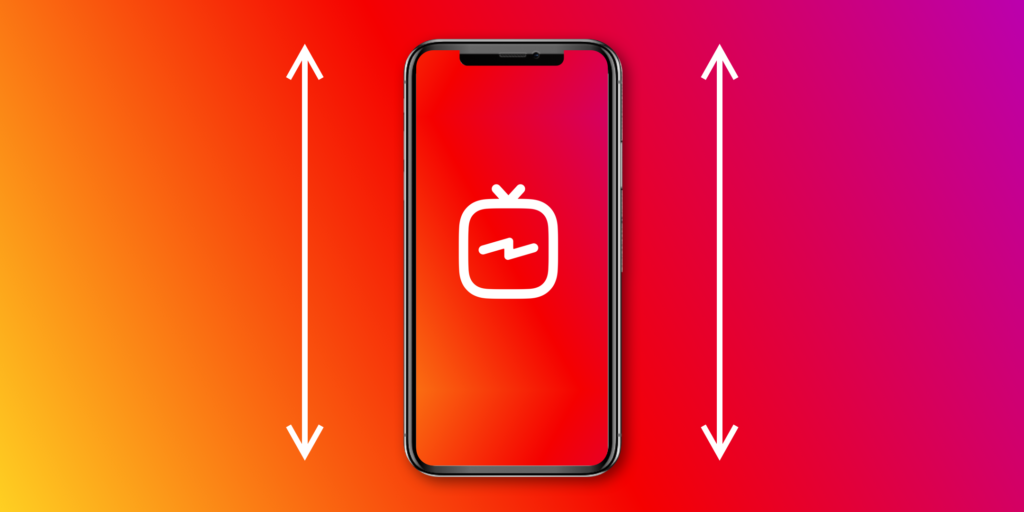Adobe Premiere Pro is a timeline-based video editing software application. It is part of the Adobe Creative Cloud, which includes video editing, graphic design, and web development programs. Adobe Premiere Pro provides support for several file formats, making your post-production workflows compatible with the latest broadcast formats.
Premiere Pro Supported native video and audio formats
| Format | Details |
| HEVC (H.265) | H.265 8K UHD media with resolutions up to 8192×4320 in MXF |
| H.264 AVC | Various media that use H.264 encoding |
| DNxHR | DNxHR LB, DNxHR SQ, DNxHR TR, DNxHR HQ, and DNxHR HQX |
| OpenEXR | Files in .EXR, .MXR, and .SXR formats |
| 3GP, 3G2 (.3gp) | |
| Apple ProRes 64-bit | Import only on Windows |
| ASF | Netshow (Windows only) |
| AVI (.avi) | DV-AVI, Microsoft AVI Type 1 and Type 2 |
| DV (.dv) | Raw DV stream, a QuickTime format |
| DNxHD | Supported in native MXF and QuickTime wrappers |
| F4V (.f4v) | Import only |
| GIF (.gif) | Animated GIF |
| M1V | MPEG-1 Video File |
| M2T | Sony HDV |
| M2TS | Blu-ray BDAV MPEG-2 Transport Stream, AVCHD |
| M4V | MPEG-4 Video File |
| MOV | QuickTime Movie format
Note: Windows requires a QuickTime player |
| MP4 | QuickTime Movie, XDCAM EX |
| MPEG, MPE, MPG | MPEG-1, MPEG-2 |
| M2V | DVD-compliant MPEG-2 |
| MTS | AVCHD |
| MXF | Media eXchange Format
MXF is a container format that supports:
Note: You can preview Native Canon XF files in the Media Browser, |
| Native MJPEGs | 1DC |
| VOB | |
| WMV | Windows Media, Windows only
Note: Render Type-1 AVI clips before previewing from a DV device. |
Premiere Pro Supported native camera formats
Premiere Pro lets you work with a wide range of native media formats from the latest DSLR cameras without transcoding or file rewrapping.
The media formats listed here are supported for directly importing and editing with Premiere Pro CC. The required codecs are built into Premiere Pro CC and supported on both Mac OS and Windows systems unless stated otherwise.
https://helpx.adobe.com/premiere-pro/using/supported-file-formats.html
| ARRI AMIRA camera | Premiere Pro provides built-in support for the ARRI AMIRA camera, with appropriate color LUTs applied as master clips on import. |
| Canon XF, Canon RAW | You can work natively with Canon XF and Canon RAW footage, including footage from Canon Cinema EOS C300 and C500 cameras.
Premiere Pro lets you import and edit QuickTime formats natively including Apple ProRes and MOV files that Canon 5D and 7D cameras capture. You can clip metadata without any transcoding, rewrapping, or logging and transferring required . |
| CinemaDNG | Premiere Pro lets you import and edit uncompressed CinemaDNG media from the following cameras:
When working with CinemaDNG media, you can access the Source Settings and edit the metadata parameters. CinemaDNG can be debayered on a supported GPU for extreme playback performance. |
| Panasonic AVC, P2 cameras | You can natively import and edit media from the following cameras:
|
| Phantom Cine media | You can natively import and edit Phantom Cine media shot on Vision Research Phantom cameras. |
| RED support |
Premiere Pro CC supports working natively with RED Digital Cinema (R3D) footage from the following cameras:
Note: RED format clips use the GPU (OpenCL and CUDA) for debayering for an improved and faster playback performance. |
| Sony cameras | You can import and edit media from the following cameras directly, without rewrapping or transcoding:
You can browse the imported clips using the Media Browser and organize them using camera metadata. |
Premiere Pro Supported audio file formats
| Format | Details |
| AAC | |
| AC3 | Including 5.1 surround |
| AIFF, AIF | |
| ASND | Adobe Sound Document |
| AVI | Video for Windows |
| BWF | Broadcast WAVE format |
| M4A | MPEG-4 Audio |
| mp3 | mp3 Audio |
| MPEG, MPG | MPEG Movie |
| MOV | QuickTime; requires QuickTime player |
| MXF | Media eXchange Format
MXF is a container format that supports:
|
| WMA | Windows Media Audio, Windows only |
| WAV | Windows Waveform |
Premiere Pro Supported still-image and still-image sequence file formats
Note: Premiere Pro supports 8bpc (4 bytes per pixel) and 16bpc (8 bytes per pixel) still-image files.
| Format | Details |
| AI, EPS | |
| BMP, DIB, RLE | |
| DPX | |
| EPS | |
| GIF | |
| ICO | Icon File (Windows only) |
| JPEG | JPEG, JPG, JFIF |
| PICT | |
| PNG | |
| PSD | |
| PSQ | Adobe Premiere 6 Storyboard |
| PTL, PRTL | Adobe Premiere title |
| TGA, ICB, VDA, VST | |
| TIF |
Premiere Pro Supported closed captioning and subtitle file formats
| Format | Details |
| DFXP | Distribution Format Exchange Profile |
| MCC | MacCaption VANC |
| SCC | Scenarist Closed Caption File |
| STL | EBU N19 Subtitle File |
| XML | W3C/SMPTE/EBU Timed Text File |
Premiere Pro Supported video project file formats
| Format | Details |
| AAF | Advanced Authoring Format |
| AEP, AEPX | After Effects project |
| CSV, PBL, TXT, TAB | batch lists |
| EDL | CMX3600 EDLs |
| PLB | Adobe Premiere 6.x bin (Windows only) |
| PREL | Adobe Premiere Elements project (Windows only) |
| PRPROJ | Premiere Pro project |
| PSQ | Adobe Premiere 6.x storyboard (Windows only) |
| XML | FCP XML |
About file formats
Some filename extensions – such as MOV, AVI, MXF, and F4V – denote container file formats rather than denoting a specific audio, video, or image data format. Container files can contain data encoded using various compression and encoding schemes. Premiere Pro can import these container files, but the ability to import the data that they contain is dependent on the codecs (specifically, decoders) installed.
By installing additional codecs, you can extend the ability of Premiere Pro to import additional file types. Many codecs installed into the operating system (Windows or Mac OS) work as a component inside the QuickTime or Video for Windows formats. Contact the manufacturer of your hardware or software for more information about codecs that work with the files that your specific devices or applications create.
Note: Video and still-image files that you want to import must not be more than the maximum dimensions allowed. For more information on maximum dimensions in Premiere Pro, see the Premiere Pro Work Area blog.
Why can’t Premiere Pro import my file?
If you’re trying to import a file into Premiere Pro, and Premiere Pro is telling you that it can’t import that file, this could be for a few different reasons. And there are three most common reasons that you might not be able to import a file into Premiere Pro.
1. You might be running the trial version of Premiere Pro CS6 or earlier. Note that Premiere Pro CC doesn’t have these limitations on the trial version.
2. You might be trying to import a file of a format that Premiere Pro doesn’t import, so check the file for format supported for import, to see if your file is listed.
3, If you’re trying to import a file, in a container that Premium Pro does support, it may be that codec used in that container file, is not one that Premium Pro can import.





